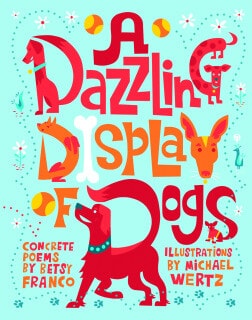
As Children’s Poet Laureate, one of my jobs is to select a collection of poetry each month to feature on the Poetry Foundation’s website. There you’ll find my monthly book picks, and those of the previous Children’s Poets Laureate.
My pick for August, 2013 is A Dazzling Display of Dogs, concrete poems by Betsy Franco, illustrations by Michael Wertz.
Interview with Children’s Author Betsy Franco
In addition, I interviewed Betsy Franco about her life as a poet and about her new book. Here is what she had to say.

Kenn Nesbitt: How did you come to start writing children’s poetry?
Betsy Franco: Decades ago, an innovative math textbook author asked me to write math poems for chapter openers. The poems were never used, but I never stopped writing.
KN: Who/what are your influences when writing children’s poetry?
BF: I was, of course, obsessed with Shel Silverstein and read his poetry to my kids who loved his offbeat humor. Early on, I was lucky that my best friend, Maria Damon, a professor at Pratt, was willing to be my poetry mentor. She fed me avant-garde poetry by poets like Bob Grumman who writes elegant long division poetry. She sent me other exciting examples of visual poetry and free verse that were on the cutting edge in the adult poetry world, and I loved the challenge of making them accessible to children.
KN: What do you think poetry does for children?
BF: Poetry fits the natural rhythms of children who are often galloping or skipping; they even tell stories in a sing-songy rhythm. Poems work for all kinds of young readers because there’s so much white space; in fact, I’ve often had ESL and Special Ed teachers say that my poetry reaches their students much better than prose. I’m not surprised because poetry is magical to me. It brings out feelings and thoughts that can’t be accessed through any other medium or genre, and when I have kids write poetry based on my books, such as A Dazzling Display of Dogs, the results are often better than my own work.
KN: Tell me a little bit about your career as a children’s author.
BF: Once I had James and Tom, my first two sons, I couldn’t find the time or a safe place to set up my oil paints. So I turned to my pencil and transferred all the creative energy I’d used for painting into writing. Poetry was a natural for me. I express myself economically, I love puzzles, I respond to rhythm (especially since taking swing dance lessons) and I get a kick out of playing with language.
I write in a variety of forms. Mathematickles! was my breakthrough poetry collection–it’s a bit like math haiku. Then came books like Bees, Snails, and Peacock Tails, Pond Circle, and Messing Around on the Monkey Bars. I enjoy playing with kids’ minds by combining two subjects that don’t normally live together: math and poetry, science and poetry. I even had Ovid, the protagonist in my young adult novel Metamorphosis, Junior Year, write in prose and poetry. His poetry was my favorite part of the novel, and I retained it in the play I wrote based on the book. The teen actors did a beautiful job of engaging in natural conversations in free verse.
KN: Tell me about your poetry collection, A Dazzling Display of Dogs.
BF: The research I did for A Dazzling Display of Dogs was pure fun. I interviewed all my neighbors and family members and collected stories about their dogs. I stopped people on the sidewalk and in shopping areas and asked them for anecdotes. I had written A Curious Collection of Cats as visual poems and felt that dogs needed their due. Plus, I grew up with dogs, and Takako, my barkless dog from Japan, was my best friend.
Writing the poems involved an interweaving of the visual and the text. I made sure each poem had the potential to be a visual poem. Then my wonderfully whimsical illustrator, Michael Wertz, worked his magic, from his exuberant compositions to his unusual pallets. We were bound together in a highly integrated, creative process, and, fortunately, we have matching senses of humor.
Having been a studio art major at Stanford, I was drawn to visual poetry. Luckily I found that dogs lend themselves to this type of poem because they’re constantly doing comical and beautiful things with their bodies.
I wanted to mix it up, showing all types of visual poems, concrete and otherwise. Some poems involve shapes filled with words such as the poem inside the ball in “Emmet’s Ode to His Tennis Ball.” The text reflects the action in “Coco Circling the Rug.” In “Pug” the letters of the word pug form the face and paws of the dog. The back and forward slashes on the keyboard were perfect for a door in “Letting Gwen In and Out.”
I’d never seen a whole book of visual poems all on the same subject and wanted to take the challenge. I worked doggedly on this collection and enjoyed myself tremendously!






